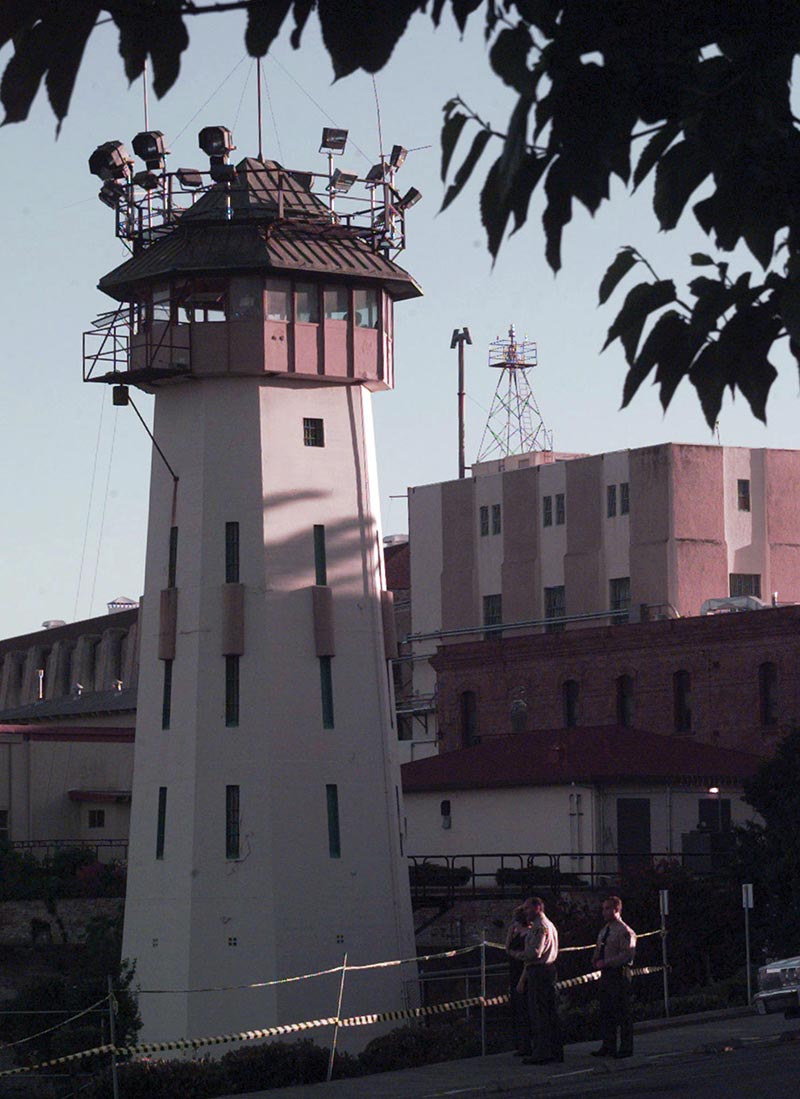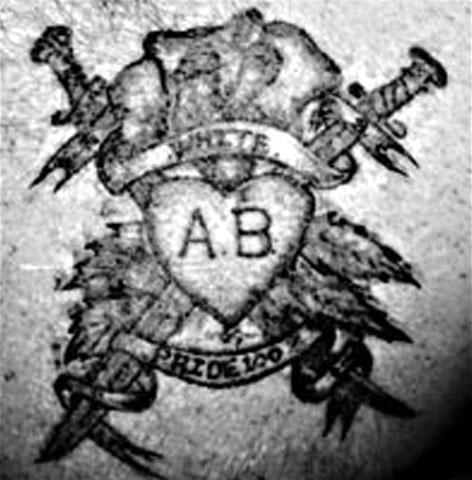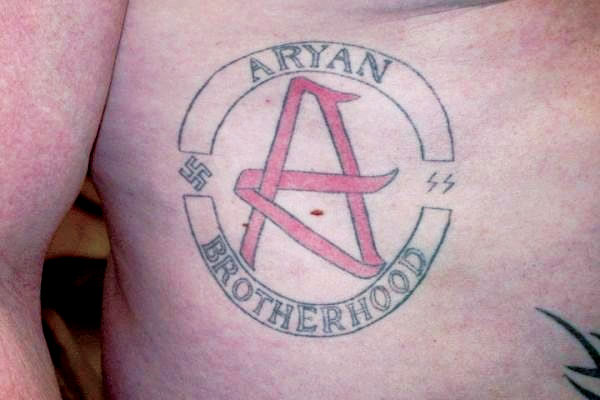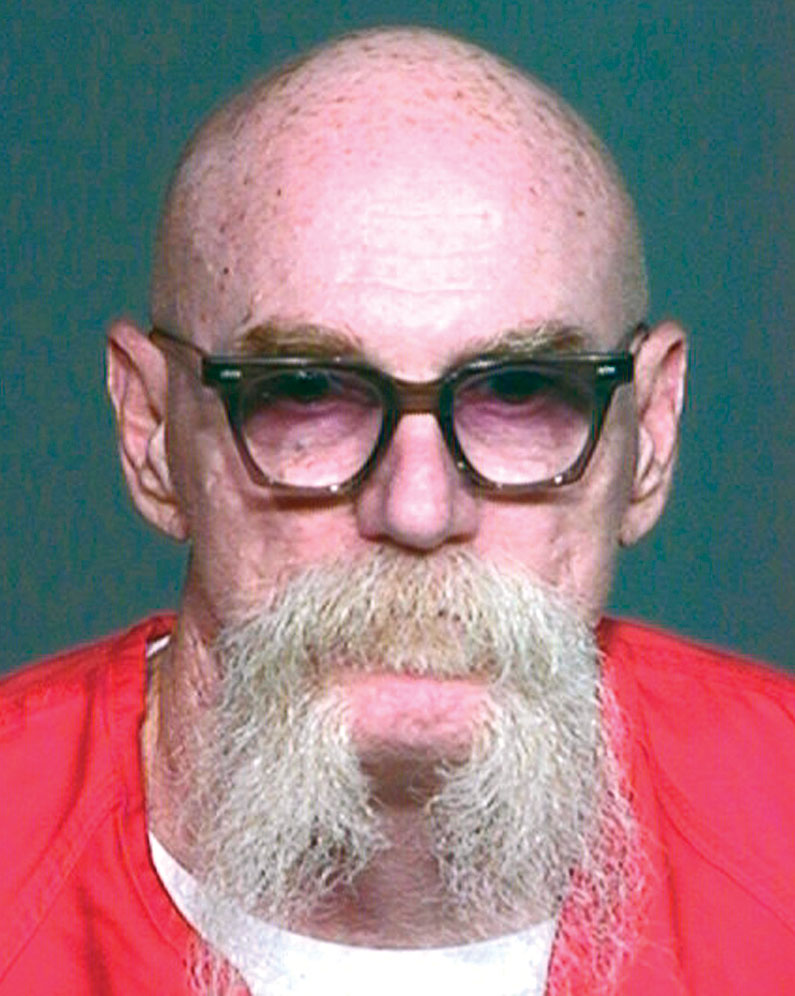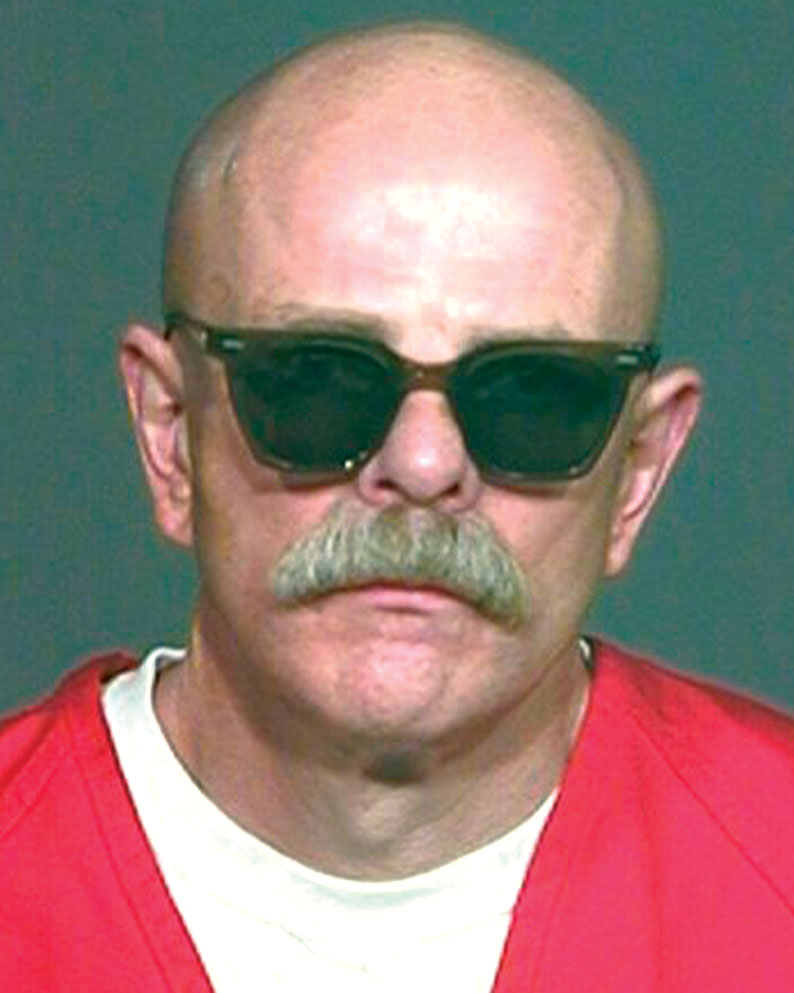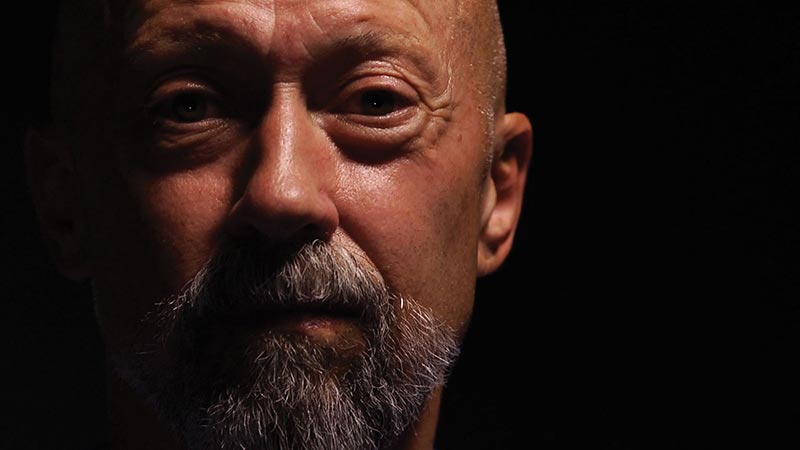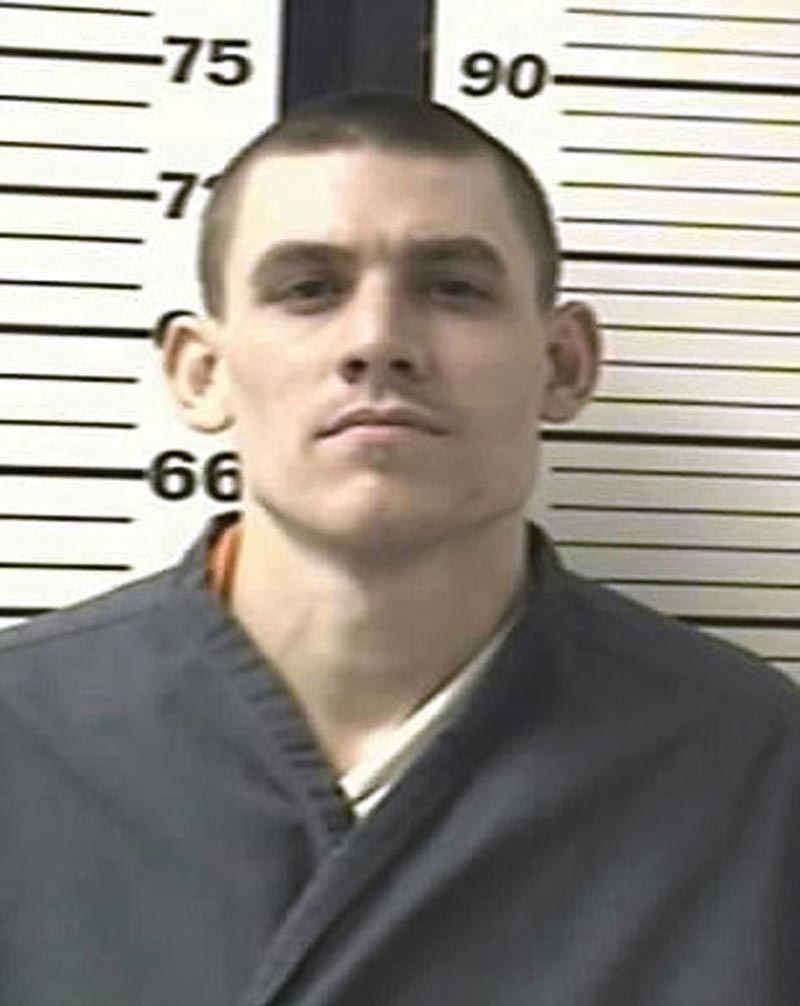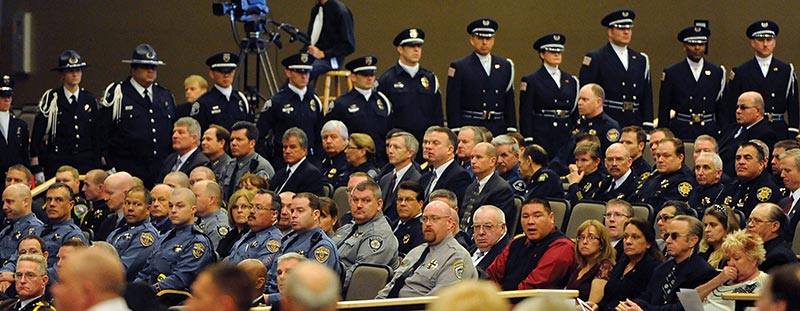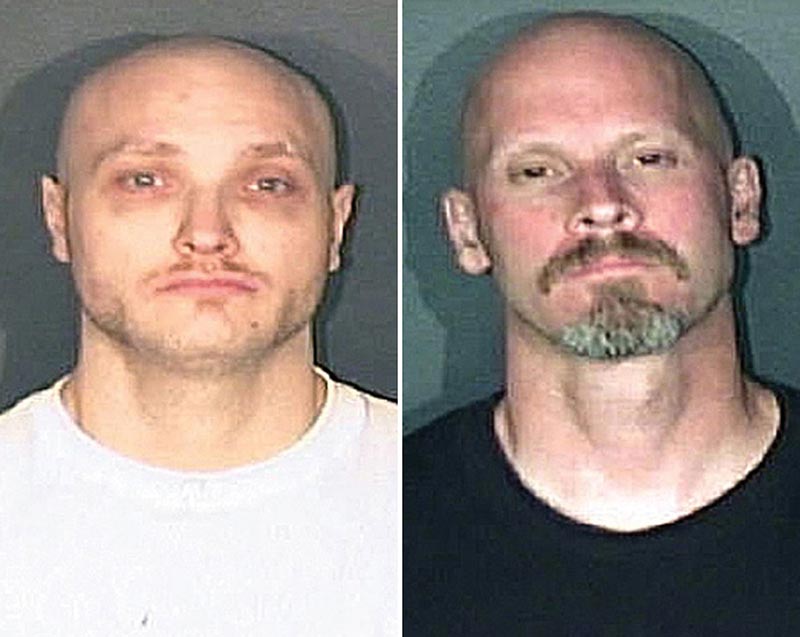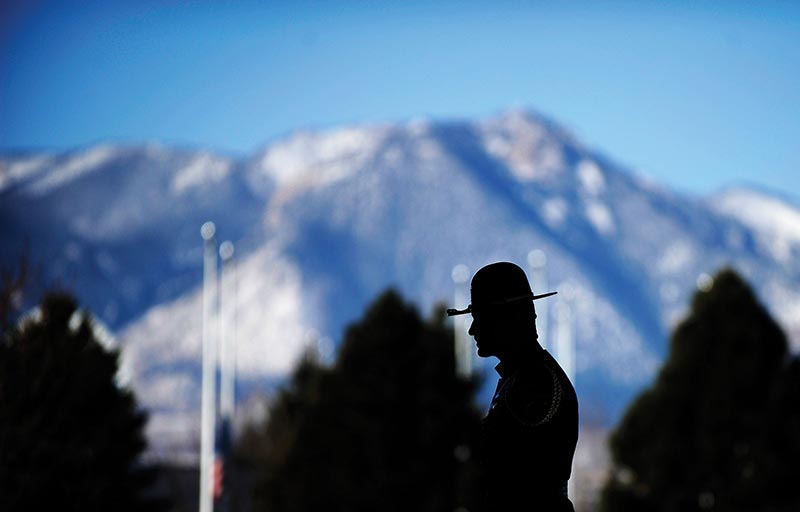Intelligence Report Special Edition - Aryan Prison Gangs
An examination of white supremacist prison gangs, including articles that previously appeared in the Intelligence Report.
An examination of white supremacist prison gangs, including articles that previously appeared in the Intelligence Report.
SANTA ANA, Calif. — Within the Ronald Reagan Federal Building and United States Courthouse here is a courtroom called the “Nuremberg room” for its resemblance to the famous chamber in which 22 leaders of the Third Reich were tried in 1945 and 1946 for crimes against humanity.
Both halls of justice have three-tiered docks where multiple high-profile defendants are shackled to anchors in the floor by chains hidden from view behind tables and podiums. Like the docks in Germany’s Palace of Justice 60 years ago, the docks in Santa Ana this year have filled with self-avowed Nazis, Aryan warriors, and followers of Hitler.
But the Nazis standing accused in California are Nazis of a wholly different strain than Nuremberg War Crimes Tribunal defendants like Hermann Goering and Rudolf Hess. They are white supremacist pimps, drug dealers and backstabbing shower-stall killers, glorified thugs with swastika tattoos. They covet power and oversee a criminal empire, but they are motivated less by furthering their die-hard racist ideology than satisfying their crude greed. They are the leaders of the Aryan Brotherhood (AB), the most notorious, powerful, and violent prison gang in America. Also known as the Brand or the Rock — a reference to the Shamrock tattoos AB members favor in addition to Nazi insignia — the gang in recent years has established criminal networks outside prison walls in cities, small towns, and suburbs across the country.
Their nicknames are worthy of professional wrestlers — Super Honky, The Baron, Lucifer — but the blood they have spilt by the bucketful has been all too real. Aryan Brotherhood members make up less than one-tenth of one percent of the nation’s prison inmate population, yet the white power gang is responsible for 18% of all prison murders, according to the FBI.
The AB’s carnage has spanned four decades. In 1981, two members of the Brotherhood who were incarcerated at the federal prison in Marion, Ill., murdered the leader of a rival gang, the D.C. Blacks, by sneaking up behind him in the shower and then brutally stabbing and slashing him 67 times. They then dragged his bloody, mutilated corpse through a cellblock while white inmates cheered and chanted racial slurs.
“I have walked over dead bodies,” one of the AB assassins in that case later boasted in court. “I’ve had guts splattered all over my chest from the race wars.”
The Last Arrow
Law enforcement authorities and prison officials have until now been unable to destroy the Aryan Brotherhood mainly because so many top leaders of the gang are serving life or multiple life sentences with no possibility of parole. These men laugh at criminal penalties that only add more time to their already infinite sentences.
Isolating the gang’s leaders in solitary confinement hasn’t worked either, because they always find way to communicate with each other and to transmit and receive reports, requests, and orders from prison to prison and down through the ranks, whether by bribing guards, subpoenaing each other to appear at court hearings where they employ hand signals and speak in code, or writing letters in a form of invisible ink made with their own urine.
These methods are time consuming. But time is one luxury the leaders of the Aryan Brotherhood possess in abundance. One sure way to stop them is to kill them, which is exactly what the federal government is threatening to do in a sweeping racketeering indictment that has drawn a rogue’s gallery of 40 Aryan Brotherhood members and associates, including virtually all of the gang’s veteran leaders, or “shot callers,” to the Nuremberg room in Santa Ana.
Twenty-one of the defendants are eligible for the death penalty, making the Aryan Brotherhood indictment the largest death penalty case in the history of the American justice system. It is a decapitation attack.
“Capital punishment is the one arrow left in our quiver,” said Assistant U.S. Attorney Gregory Jessner, who is spearheading the Aryan Brotherhood prosecution. “I think even a lot of people who are against the death penalty in general would recognize that in this particular instance, where people are committing murder repeatedly from behind bars, there is little other option.”
The indictment alleges that over the past quarter century, Aryan Brotherhood members either personally committed or solicited 32 murders and attempted murders in order both to promote the gang’s stature in prison and to maintain the AB’s iron-fisted control of narcotics trafficking, male prostitution, gambling, and extortion among white inmates.
In one example, the indictment alleges that in 1997, AB leaders responding to an outbreak of racial violence inside the federal penitentiary in Marion issued a “formal declaration of war” on black inmates throughout the federal prison system by using coded phone calls and messages written in a secret double alphabet invented by Sir Francis Bacon in 1652. When they received their orders, AB operatives in the federal pen in Lewisburg, Penn., executed a carefully coordinated, simultaneous attack on black inmates, killing two and severely wounding four.
“My brothers and I have went to war, (make no mistake it is war) with all of mongoloid races at one time or another, using knives, pipes, locks/rocks in socks,” a member of the Aryan Brotherhood in Oklahoma who identified himself as “tree 1488” posted to a forum on prison gangs on the white supremacist Stormfront Web site in June. (The numbers 14 and 88 are both common white supremacist identifiers.) “At the end of some of these confrontations somebody is needed to be medi-flighted out, nearly always someone has had to go to medical. I carry my scars/badges of battle. Death is a very real possibility.”
The racketeering indictment further alleges that Aryan Brotherhood leaders in prison have contracted killings and other violence by operatives in the free world to collect debts, silence witnesses, and crush competition. Wives and girlfriends of incarcerated AB commonly help smuggle drugs into prison, and deliver messages back to AB members and minions in the free world. Four women are named in the current federal racketeering indictment for acting as couriers of information, drugs, and money.
While the precise number of Aryan Brotherhood members and associates is not known, the gang has chapters in virtually every major state and federal prison in the country. Estimates of AB’s total strength vary widely, but nearly all exceed 15,000 members and associates nationwide, with roughly half in prison and half out.
“You gain ranks by battles, by ‘missions,’ not all of it locked up,” explained tree 1488. “Brothers grow as close as vets do when they go into battle fighting for a common cause. We are there for each other even on the outside. I have a high ranking it has taken me nearly seven years of missions to earn.”
The Oklahoma Aryan Brotherhood member went on the explain to the white nationalists on Stormfront that when he was first released from prison, “my neighbors on the outside were taken aback by my tattoos at first — sleeved out arms with shoulder caps that read ‘Aryan Honor,’” but that he gradually won them over with his gardening and baking acumen. “I give them fresh vegetables when they are in season, cakes and so forth. I clue them in to white nationalism if they show an interest. Aryan Honor is the credo I live by.”
Through the Past, Darkly
Most prisons were racially segregated until the 1960s. When they were desegregated, racial violence flared and inmates formed gangs along color lines. In 1964, white inmates at San Quentin Maximum Security Prison in San Quentin, Calif., founded the Aryan Brotherhood. From the beginning, the gang was steeped in racial hatred and neo-Nazism. The founders adopted swastikas and Nazi SS lightning bolts as the Aryan Brotherhood’s identifying symbols and tattoos. Recruits were ordered to read Mein Kampf and to “earn their badge” of membership by attacking — and often killing — black inmates.
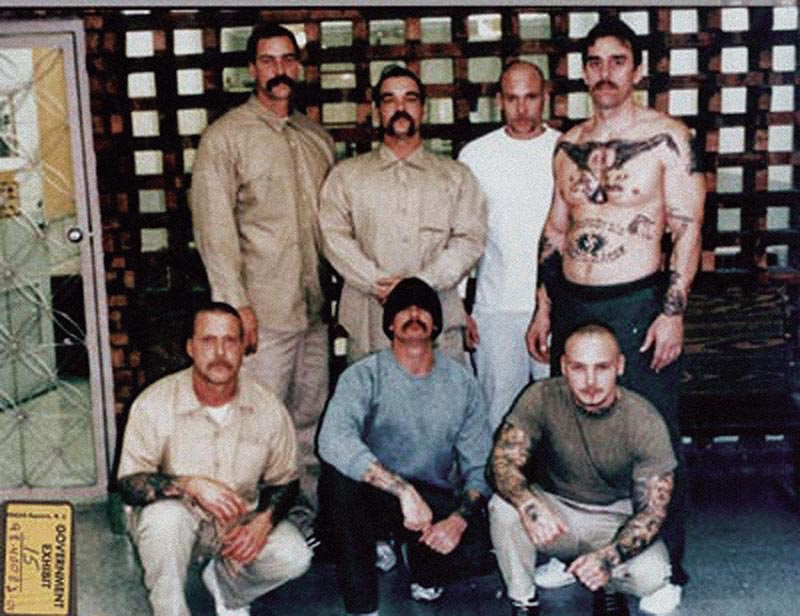
In 1973, no less a reputed mad-dog killer than Charles Manson was rejected by the Aryan Brotherhood when he asked to join but then refused to murder for skin color alone. “The AB want Manson to kill a black because black is black,” Manson’s lieutenant Lynette “Squeaky” Fromme wrote in a letter. “He will not do this and they are against him.”
Throughout the 1970s, as the gang expanded, the AB constantly battled with black and Hispanic prison gangs in slow-burning wars of attrition fueled by racial hatred but truly fought over territory and profits. Then as now, the Aryan Brotherhood was both a white supremacist organization and a criminal syndicate. “There’s no doubt the Aryan Brotherhood are a bunch of racists, but when it comes to doing business, the color that matters most to them isn’t black or brown or white — it’s green,” said prison gang expert Tony Delgado, Security Threat Group Coordinator for the Ohio Bureau of Rehabilitation and Correction.
Whereas the Order — a high-profile gang of hardened white power criminals who in the early 1980s robbed armored cars, counterfeited currency and machine gunned to death a Jewish radio host — killed and robbed mainly to further the cause of white supremacy, the Aryan Brotherhood reverses that formula. The AB uses the white supremacy movement to further its criminal endeavors.
“The white power thing is mostly just a good recruiting tool and a way to maintain structure and discipline,” said Delgado. “These guys are more about making money than starting any kind of white revolution. They sell heroin to white people all the time. That’s not very Aryan or brotherly of them.”
Joining the Movement
In 1980, the Aryan Brotherhood split into two separate but cooperative factions, one for gang members in federal custody and the other for gang members in state prisons, who had by then proliferated to Colorado, Arizona, Missouri and New Mexico. The federal faction of the gang formed a three-man “commission” to supervise and direct all Aryan Brotherhood actions inside federal prison. In 1982, the state prison AB faction followed suit.
Initiates to both factions swore lifelong allegiance to the gang with the same blood oath: “An Aryan brother is without a care/ He walks where the weak and heartless won’t dare/For an Aryan brother, death holds no fear/Vengeance will be his, through his brothers still here.”
Also in the 1980s, the imprisoned leaders of the Aryan Brotherhood began to cultivate relationships with the leaders of neo-Nazi and white supremacist organizations outside prison, most notably Aryan Nations. AB members in Missouri unsuccessfully challenged that state’s ban on inmates receiving Aryan Nations literature, and AB members all over the country joined Aryan Nations under its alter-ego name, Church of Jesus Christ Christian. This “church” is a purveyor of the “Christian Identity” religion preached by late Aryan Nations founder and head Pastor Richard Butler, whose “prison ministry” for decades promoted the doctrine that non-whites are “mud people” and Jews are the literal descendants of Satan.
Very few Aryan Brotherhood members are sent to prison originally for hate crimes. Typically they’re sent up on robbery or drug charges and then join the gang for protection. But once they’re members of the AB, white prisoners are indoctrinated into the virulent ideology of race war.
“We do what we have to do to make it in prison. If any of you ever have to go there you will fully understand. Until then you won’t,” a member of the Aryan Brotherhood posted in June to a Stormfront forum on which white supremacists were debating whether the Aryan Brotherhood should be embraced or shunned by white power activists.
“My name is Michael but all my brothers call me ‘tattoo.’ I am an overseer for the Alabama Aryan Brotherhood. I am currently incarcerated in Bibb County Correctional Facility in Brent, Alabama. I want to set the record straight on a few things I’ve head on this forum. The Aryan Brotherhood, my family, will always be a big part of the White Nationalist movement! We are under a blood and honor oath to live by the 14 words ‘We must secure the existence of our people and a future for white children.’ Any true soldier not only lives by these words but they would be embedded in his heart and soul. Rahowa! [Racial Holy War].”
Once they’re released, some Aryan Brotherhood members commit terrible hate crimes in the name of Rahowa. The most infamous racially motivated murder since the civil rights era occurred in 1998, when three white men, two of them ex-cons, tied a black man, James Byrd Jr., to the back of their pickup truck with a logging chain, dragged him to death over three miles of country roads outside Jasper, Texas, and then deposited his shredded remains in front of a predominantly black cemetery. One of the ex-cons testified at his trial that he and one his accomplices had both joined the Aryan Brotherhood of Texas for protection from black inmates while they were incarcerated. When he rejoined society, his arms were covered with Aryan Brotherhood tattoos, including one depicting a black man being lynched. “You look at his arms,” the trial prosecutor said, “and you see what’s in his heart.”
In October 2001, another member of the Aryan Brotherhood of Texas who was enraged by the Sept. 11 terrorist attacks gunned down a Bangladeshi gas station attendant simply because the victim “looked Arab.”
The AB has reportedly toyed with terrorist plots of its own. In 2000, a longtime Brotherhood member and explosives expert-turned-government informant told federal investigators he had been approached by AB leaders inside Colorado’s Supermax federal prison who asked him to provide them with technical information on making bombs in preparation for a series of attacks on federal buildings and officials across the country.
“It’s become irrational,” he said, according to an FBI report. “They’re talking about making car bombs, trucks bombs, mail bombs.”
In Ohio, Another Case
Just before dawn this June 23, a strike force of more than 125 federal and local law enforcement officers, including six SWAT teams, mustered at a mobile command center in Painesville, Ohio, a suburb of Cleveland. After a briefing, the force divided into no-knock search teams that surrounded and then raided six houses spread across four counties in northeastern Ohio. According to indictments released later, the houses contained stashes of illegal weapons and drugs belonging to the Order of the Blood, a criminal network financed and managed by the Aryan Brotherhood and the Pagans, an outlaw motorcycle gang.
The pre-dawn raids resulted in the seizure of 60 weapons, including 13 fully automatic machine guns, plus large amounts of methamphetamine, cocaine, heroin, and the prescription painkiller Oxycodone. Thirty-four members and associates of the Aryan Brotherhood were arrested, and warrants were issued for 10 still at large. The sweep came after a 20-month undercover investigation that shifted into high gear earlier in June, when police in Willowick, Ohio, arrested two members of the Aryan Brotherhood for possessing illegal machine guns and found in their vehicle a file containing detailed personal information about two police officers in nearby Eastlake whose lives had been threatened two years ago by members of the Pagans.
“This case has all the elements of organized crime and has tentacles spread over a wide area,” said Lake County Sheriff Daniel Dunlap. “These were not informal gang bangers flashing gang signs. These were hardened criminals operating in our midst.”
Polishing the Rock
There are roughly 550 members of the Aryan Brotherhood in prison in Ohio, said Tony Delgado, the Ohio prisongang expert, and another 500 members on the streets who, like AB members everywhere, are bound by the gang’s blood-and-honor code to follow the orders of their incarcerated leaders. According to a recently declassified FBI report on the Aryan Brotherhood, “The rule of thumb is that once on the streets, one must take care of his brothers that are still inside. The penalty for not doing so is death.” This practice is known within the gang as “polishing the rock.”
The rock is getting polished all over the country, even in Fairbanks, Alaska, a city of 30,000 deep in the interior of the Last Frontier. Sgt. William Hathaway, a security officer at the Fairbanks Correctional Center, said that an Aryan Brotherhood associate, or “Peckerwood,” from the gang’s Arkansas faction arrived in Fairbanks last year and began actively recruiting other Peckerwoods among the city’smethamphetamine users anddealers to help set up an AB-financed drug ring. (Inside and outside prison, Peckerwoods areAryanBrotherhood wannabes who do the gang’s bidding in exchange for some degree of prestige, profit, and protection; occasionally a Peckerwood will become a full-fledged member, usually after carrying out a “hit” on an AB enemy.)
“He professes the Peckerwoods to be a ‘white power gang,’ and he is fairly successful in his efforts,” said Sgt. Hathaway. “I have noticed severalt-shirts lately with a woodpecker riding a motorcycle and the wording, ‘Peckerwoods, this wood don’t burn,’ in our community this summer where none were noticed before.”
Sgt. Hathaway said the Arkansas Peckerwoodwas imprisoned in Fairbanks after being convicted on a drug charge and is currently awaiting trial for plotting an escape in which he and 11 accomplices planned to murder correctional officers and Fairbanks patrolmen.
“He is continuing his recruiting within our facility,” said Sgt. Hathway. “He corresponds with the local leader of the Aryan Brotherhood and counts several of the incarcerated Hell’s Angels as his friends. He seems to be getting a large following within our prison.”
Lightning Storm
There is no way to precisely estimate the number of Aryan Brotherhood members and associates in the United States. But there is little question about how far and wide the AB’s lightning bolts strike. When the U.S. attorney’s office in Santa Ana released the multiple death-penalty indictment, 30 of the 40 accused were already in prison, but the remaining 10 were arrested in simultaneous raids in California, Colorado, Connecticut, Florida, Georgia, Illinois, Louisiana, Massachusetts, Nebraska, New York, Pennsylvania and Washington.
And in January, in a dragnet similar to the Ohio bust, more than 70 federal, state and local officers swarmed three suspected AB haunts, including a motorcycle shop in Ruidoso Downs, N.M., a small town in the Rocky Mountains where newly released members of the Texas Aryan Brotherhood were allegedly setting up a burglary and methamphetamine-dealing ring. The month before in the nearby town of Cloudcroft, N.M., a local deputy was killed (see story, p. 41) in a shootout with AB member Earl Flippen, whose arms were adorned with tattoos of Iron Eagles, dragons, skulls, and the motto ‘White Pride.” Flippen was wounded in the initial exchange of gunfire, then finished off with a single shot to the heart by the slain deputy’s partner, a 33-year law enforcement veteran who subsequently pleaded guilty to voluntary manslaughter. Flippen had been out of prison less than six months.
By early September federal prosecutors had obtained guilty pleas from all 19 of the AB racketeering defendants who are not eligible for the death penalty. The remaining 21 defendants are scheduled to stand trial later this year. The final and lasting effect of the federal government’s decapitation strike against the Aryan Brotherhood is unknown for now. But even if it deals a lethal blow to the gang’s leadership, with thousands of rank-and-file members due for release from prison in the next decade, the death throes of the Aryan Brotherhood might be long and nasty.
“Someday most of us are finally going to get out of this hell,” the AB hit man who murdered the leader of the D.C. Blacks in 1981 recently declared from solitary confinement. “And even a rational dog after getting kicked around year after year after year attacks when his cage door is finally opened.”
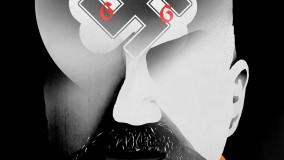
“For the Aryan Brotherhood, murder is a way to make a social statement,” said John Greschner, a former top leader of the gang.
“If blacks attack whites, we send a message. We go pick one of their shot callers. We catch them walking across the [prison] yard under guard escort in handcuffs. It don’t matter. We’re going to butcher him in handcuffs in front of God and everybody at high noon in the middle of the yard. And it’s not just going to be a few clean stab marks. It’s going to be a vicious, brutal killing. Because that’s how brothers [AB members] take care of business, and a brother’s work is never done.”
Greschner joined the Aryan Brotherhood (AB) in 1977 about13 years after white prisoners formed the gang in the recently desegregated San Quentin State Prison in California. When he joined, Greschner said, there were 50 to 60 members and associates of the AB.
Now, according to federal law enforcement agencies, there are roughly 20,000.
The gang that Greschner said was “started up as a white self-defense group in a single pen,” has evolved into a multinational criminal syndicate with hugely profitable drug trafficking and gambling operations and protection rackets within prisons across the country. On the streets, the AB is involved in practically any profitable criminal enterprise, including murder-for-hire, armed robbery, gun running, methamphetamine manufacturing, counterfeiting and identity theft.
“It’s an empire,” Greschner said in a recent interview with the Intelligence Report. “That’s what I helped it become.”
As one of three members of the AB “commission” overseeing all gang activity based in the federal prison system — activity that often reaches far beyond prison walls — Greschner was directly responsible for increasing the size and sophistication of the Aryan Brotherhood during two key decades of rapid expansion for what is now the largest and deadliest prison-based gang in the country.
Along with vetting prospective members and voting on leadership decisions, including targeted killings, Greschner by his own account personally instituted a banking and collections system for the gang and developed complex written codes for communicating between prisons and with members and associates in the free world. He was also the gang’s resident expert in improvised weapons, including poisons and explosives he cooked up in prison cells.
Now 60 years old, Greschner is serving a double life sentence for murder and conspiracy to commit murder resulting from the 1984 killing of a fellow inmate at the United States Penitentiary in Leavenworth, Kan. Greschner said the man was killed because he refused to pay a large gambling debt owed the AB.
“We made sure to get the word out: If you burn the AB, you go in the hat, meaning there’s a contract on your life,” said Greschner. The phrase “in the hat” refers to the early years of the gang, he said, when AB members in a certain prison would draw pieces of paper out of a hat to determine which of them would carry out a contract murder.
“Once you’re in the hat, you ain’t getting out of the hat. Ever. Thirty years later, if a brother sees you somewhere, you’re going down. In the streets, in jail, it doesn’t matter. They’re gonna get you.”
Greschner used to put names in the hat. Now he’s in the hat. He severed ties with the AB and debriefed with federal investigators in 2001 following a bitter feud with the gang’s most notorious member, longtime AB commissioner and original co-founder Barry “The Baron” Mills, who recruited Greschner to join the gang 35 years ago. Now Greschner’s speaking to a wider audience.
‘The Brightest Light Shining’
Currently held in federal protective custody at a prison in the western U.S., Greschner earlier this year sat with hands and feet shackled for a three-hour interview. (As a condition of the interview, the Report agreed to withhold the name of the prison to protect Greschner.) With neatly trimmed grey hair, a beard to match, and blue eyes that rarely blink, Greschner slouched casually in his chair, a hooked toothpick strung with dental floss clenched between his teeth.
One thing he wanted to make clear right away: He’s not a racist. Before he joined the AB, he did stick-ups with black partners, Native American partners, no problem. His cellmate these days is black. They get along fine, even though Greschner has a swastika tattoo, which he insisted is the Sanskrit version, not the Nazi kind.
“To me, it’s a Buddhist thing,” he said. “I’m a yogi.”
Despite the swastika tattoos widely popular with its members, the vast majority of whom are neither Buddhists nor claim to be, the Aryan Brotherhood as it exists today is not a hate group in the traditional sense.
Although widely idealized by racist skinheads and other hard-core white supremacists, the AB in reality is far more about gaining power and reaping profit than promoting white racial unity or furthering any kind of white power revolutionary cause. If there’s bigtime money to be made in dealing with Mexican drug cartels, AB shot callers won’t let skin color get in the way.
However, many AB members do practice a racist variant of the neo-pagan religion Asatru, the faith of Viking raiders of old. Also, rank-and-file members of the gang commonly espouse “race war” rhetoric as justification for violence. According to Greschner, the AB began cynically using what he called “the race thing” as a recruiting tool in the 1980s to foster a sense of common identity and harden loyalty to the gang, particularly among new members, who might otherwise turn snitch.
“I was telling Barry [Mills] at one time, I said, ‘Look, man, we gotta have some deeper catalyst that pulls people in and holds them together. Because when you’re harvesting criminals [as members], criminals are fine, but criminals are in the game a lot of times only to get what they can for themselves, so if you put a lot of pressure and heat on, you can get them to roll over,’” said Greschner. “‘But if you give them something deeper they can feel connected to, maybe some northern European religion or whatever, and some racial thing and all that, well, they’ll start to feel like they’re down with a greater cause that they’re fighting for, and then they won’t roll.’ That’s what I told Barry.”
According to Greschner, AB leaders also recognize the value of exploiting the gang’s legendary image within the American skinhead movement to easily absorb skinhead crews throughout the country whenever a high-ranking member of a particular skinhead crew enters the prison system.
“This is what happens,” he said. “The loudest ringing bell, as far as any white group out there goes, is the Aryan Brotherhood. They’ve all heard of us. They all want to be us. We’re the brightest light shining. And, you know, we’ve got people everywhere out there [outside prison], keeping us up to date on all the little white crews in the United States — all the little skinhead crews, the European Kindred, the LRs [Nazi Low Riders], the PENI [Public Enemy Number One], whatever.
“So what we do is, any time a member of one of these white crews comes in here [the federal prison system], if they’re one of their main guys, or just someone we see has the potential and the talent to step up and be with us, we pull him [recruit him to join the AB]. And through pulling him, we run his entire group out there, and usually that group has other affiliations, so we run them now. That’s mergers and acquisitions. Takeovers, but not even hostile takeovers, because all the skinheads, all these white gangster crews, they all want to be down with us anyhow.”
Joining the ‘Brand’
For Greschner, joining the AB was a natural progression in a life of crime that began when he was still just a boy growing up in Minnesota. “Pops was on the road all the time, driving 18-wheelers, Mom wasn’t there a lot, so next thing you know, I had a little street gang going back in the ’50s,” he said. “We had our leather jackets all with zippers and our engineering boots and greaser hairdos and our little gravity knives.”
Greschner was first incarcerated at the age of16 for “robberies and shootings and conspiracy stuff.” When he joined the AB in 1977, he was a 25-year-old career criminal with a string of violent felony convictions, then serving federal time for armed robbery and aggravated assault. Greschner at the time was also charged with the attempted murder of a police officer he shot during a gun battle the previous year, following his escape from a state prison in Minnesota.
At a federal prisoner transfer facility in Terre Haute, Ind., that convicts call “The Hut,” Greschner met AB cofounder Barry Mills, who, like Greschner, was awaiting transfer to a federal penitentiary in Atlanta. Heavily muscled with long blond hair, Mills had a bad eye from a knife fight with Mexican inmates in San Quentin and anAryan Brotherhood tattoo on one arm that he burned off years later.
Mills knew of Greschner’s escape and shootout with police officers, and of his reputation as a “good con,” one that kept his mouth shut and backed up other good cons. “Barry came to me and said, ‘You’re like us. You’re cut from the same cloth. You take care of your business. You’ve got good morals, good ethics, you’re a good, stand-up dude, and you’d be an asset to our organization.’”
Greschner wasn’t interested in joining a prison gang. But Mills described his vision for transforming the AB into a powerful crime syndicate. “He was talking about organizing the streets from inside the prisons. I was down.”
It was a pivotal time in the history of the Aryan Brotherhood. Prior to 1977, the gang operated solely within the California state prison system. But as Mills and other AB higher ups had entered the federal prison system in recent years they had come to see the federal system as fertile ground.
“What happened was these guys would get out of the state pen in California, and then get a federal crack [conviction] for hitting banks, or running drugs or firearms, and they’d get put in the feds in different joints all over America,” said Greschner.
“So Barry started shooting wires back to the brothers in California, saying, ‘Look, man, we got a whole country out here. We’d like to form our own thing.’ And the word came back, ‘You have our blessing.’”
From that point forward the Aryan Brotherhood divided into separate organizations: the California AB and the federal system AB. “They’re like two related but different criminal families,” Greschner explained. “They each have their commission … but they’re allies. Obviously, if we get the word from California that, ‘Hey, this guy’s coming into the feds, and he’s no good, he’s in the hat,’ we’re going to make sure he gets clipped. And vice-versa.”
Greschner helped Mills and other founders of the federal AB recruit hundreds of new members in the late 1970s, searching out “psychos” who would buy into the Asatru concept of being Viking warriors destined for paradise. “You want the maniacs, those beserkers, man, that, in their minds, they’re going to Valhalla. If they fall on the battlefield, they’re going to paradise,” he said.
In short order, the AB began taking over existing drug and gambling operations run by white inmates throughout the federal prison system, Greschner said. The leaders of these rings were offered a stark choice: join the federal AB and start taking orders — and kicking back money to the commissioners — or die.
“Our old saying was, ‘One brother.’ Meaning that one brother can walk into any joint [federal prison] and take it over. Any joint. Because the leaders of the other crews in there know that one brother has the entire Brand [AB] behind him. So if they kill that one brother, sooner or later he’ll reach from the grave through us to get his revenge.”
Into the Streets
As federal AB members were paroled or served their full sentences and were released, the gang began setting up crime groups on the streets. According to Greschner, he and Mills instituted a flat tax policy and de facto banking system in which 20% of the profits of any AB criminal enterprise on the streets was deposited into money stashes or “accounts” controlled by the commission and eventually laundered through strip clubs, custom motorcycle shops and other legitimate businesses.
The motorcycle shops, Greschner said, also served as sources for cyanide, which the AB put to several uses. “Cyanide’s used for chroming mufflers and engines, so they could order it without any hassle. We’d get a little cyanide sent in [smuggled into prison] and I’d use it to make different kinds of explosives or we’d serve a guy a hot shot [a poisoned syringe of narcotics].”
By the mid-1980s, Greschner said, the federal AB had ongoing criminal operations established in major cities across the country. The leader “on the street” in each city, or, in more sparsely populated areas, each region, was appointed by and reported directly to the three-man commission. “These are designated people we give the authority to run the day-today in their areas,” he said. “One of their responsibilities is to set up a switchboard, meaning a way to handle the mail, the phone calls.”
AB switchboards communicated with each other and relayed messages between the streets and the prisons using a complex system of codes that Greschner said he devised. “Basically it was just a bunch of different variations on a bilateral encryption system based on a code the French Underground used during World War II,” he said.
“It’s like, when you do a code puzzle in a game book, and you figure out that X means A, you know every time you run across X, it means A. But with our numbers, X may be A this time, but the next time X is B, and one sentence later it’s Z.”
Every switchboard had its own code and decryption key, which rotated often, Greschner said. “That way it was compartmentalized, as a security thing.”
In 1992, Greschner said, Aryan Brotherhood street operations received a huge boost after Italian-American Mafia boss John Gotti, the “Teflon Don,” was sentenced to life in prison without parole and transferred to the maximum security federal pen in Marion, Ill., a longtime AB stronghold. (In 1983, AB members there stabbed to death two corrections officers on the same day.)
Gotti first hired the AB to protect him in the prison, and then began to set up deals between his crews and theirs on the streets. “It’s like, it’s his world out there, but it’s our world in here, and he’s in here doing forever, so he’s in our world now, and we scratched each other’s backs,” Greschner said. “We could tap into his resources up in New York, so when we needed glassware or whatever to set up [methamphetamine] labs, hey, his crews have righteous [legitimate] businesses through their unions that can get all the glasswork, all the chemicals, and, you know, the beat just went on from there.”
The Split
Dealing with Gotti, though, had a major unintended consequence, according to Greschner. “Barry started to want to be like Gotti, he started to trip like he was some kind of godfather.” Greschner said that Mills began issuing orders without first consulting Greschner or the other commissioner, T.D. Bingham. “He was a good brother before shit started going to his head,” said Greschner. “But it got the point where I told him, ‘Look, bro, AB stands for ‘Aryan Brotherhood,’ not ‘Aryan Barryhood.’”
This occurred in the late 1990s, when Greschner, Mills, Bingham and several other key AB leaders were all incarcerated in solitary confinement cells in the ADX (Administrative Maximum) prison in Florence, Colo. Federal authorities had transferred them to the Supermax prison in hopes of disrupting AB operations by preventing them from communicating between themselves or issuing orders to the outside world.
Still, they found ways. One, Greschner said, was called “getting on the phone,” where the commissioners would drain the water from their metal toilets and then have a meeting by speaking to one another through the pipes.
Meanwhile, his relationship with Mills continued to fray. According to Greschner, he was outraged when Mills ordered hits on five AB members for what Greschner perceived as “personal beefs, not official business” (see story, p. 27). Also, Greschner later testified, Mills began pressuring him to design package bombs to be mailed to federal prosecutors, despite his protests that such a bombing campaign would cause too much collateral damage and bring too much heat.
In mid-1999, Greschner sent a message to AB members that Mills was ordering hits on his own authority, a glaring violation of the gang’s code. That October, he severed ties with the gang forever, and guaranteed his own death warrant, by testifying against a highranking member of the AB in a federal drug trafficking case.
Three years later, in 2002, 29 leaders of the federal AB were rounded up from prisons all over the country and charged with violations of the federal Racketeer Influenced and Corrupt Organizations (RICO) Act, including conspiracy to commit murder, which carries the death penalty. Greschner was not among the RICO defendants.
Federal prosecutors declared their intention to seek the death penalty against 21 of the AB shot callers, or top leaders, including the two commissioners Mills and Bingham, in a highly publicized “decapitation strike” designed to cripple the gang’s leadership. Officials said they could see no other way of preventing imprisoned AB leaders, even if held in segregation, from continuing to run the gang. The tactic failed when juries returned convictions but no death penalties. Mills and Bingham, for example, were sentenced to life without parole and returned to the ADX in Colorado, where they were already serving life with no possibility of parole.
“The worst thing the government could have done if it was looking to shut down the AB was to bring that racketeering case and pump it all up through the news media, everywhere, all the newspapers about how, ‘The only way to deal with these guys is to cut the head off the dragon,’ and then nobody gets the death penalty, not one,” said Greschner. “All they did was provide the AB with the greatest recruitment tool ever, for all these young, white, radical fools all over the country. The AB couldn’t have bought PR shit like this.”
Today, Greschner spends his days in a prison yard, meditating and practicing Kundalini yoga. He says he harbors no ill will for the Brand, though his hatred for Mills is palpable. When asked if he minds spending the rest of his natural life behind bars, he shrugs and shakes his head. “This is my ashram, man, my temple. I can close my eyes and go anywhere I want. Without coming here, I never would have gotten where I’m going.”
Greschner is eligible for parole in 2055. He would be 103.
Leaving the Aryan Brotherhood can be a dangerous business. One former leader explains why he nevertheless quit the prison gang
It’s sometimes said that the notorious Aryan Brotherhood (AB) has a “blood in, blood out” rule — that prospective members need to kill an AB enemy to join the gang, and that the only way to leave the gang is by dying. While that is not literally true in all cases, the AB is famous for the deadly way it settles scores. John Greschner, one of the gang’s top leaders, or “commissioners,” broke ties with the AB in 1999. He said he was forced to leave the gang after he exposed an alleged plot by fellow AB commissioner and AB co-founder Barry “The Baron” Mills to have five AB members who were personally disliked by Mills but had not breached gang rules killed by falsely branding them informants. In an interview with the Intelligence Report, Greschner described how he fell out with Mills and detailed the AB’s ironclad rules for killing one of its own. The Report started by asking Greschner how AB leaders decide if a member should die.
JOHN GRESCHNER: Only the commission can authorize a hit on a brother. If the commission doesn’t authorize it, and you kill a brother, no matter what the reason, if it’s unauthorized, you’re going to pay the price. You’re going to get clipped. That shit is carved in stone on the face of a mountain.
INTELLIGENCE REPORT: How does the commission authorize a hit?
GRESCHNER: It takes two commissioners to green-light a brother. So what happened with Barry was, he was coming to me, because he needed a second commissioner, and he thought I’d just rubber stamp all these hits, and he’s telling me, “These guys are informants.” But he had no evidence. And the common denominator was that he had personal beefs with them over feeling disrespected, but he’s trying to put it in my head, “Look, bro, they’re tit for tat.”
IR: Tit for tat?
GRESCHNER: “Tit for tat” is our code for rats, just like “bees and honey” means money and “laying from Bristol,” pistol.
IR: So you didn’t believe him?
GRESCHNER: Well, I wanted to see evidence. I told him, “Look, brother, I’m not cosigning that order.” And I put the word out to all the joints [federal prisons], “Barry’s saying this, but there’s no evidence, so as the second commissioner, I’m putting the brakes on his order. These hits are not authorized, and anyone who carries them out will pay with his life.”
IR: How did Mills react?
GRESCHNER: He felt I betrayed him by exposing him to all the other brothers. Well, I’m doing what I’m supposed to do as a brother. I’m doing what the ethics of our organization demand that I do, and I’m certainly doing what I’m supposed to do as a commissioner. I’m not going to throw a brother’s life away. It’s not going to happen. — David Holthouse
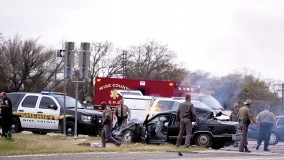
The killer rang the doorbell. Tom Clements, 58, head of Colorado’s prison system was shot dead as he opened his front door shortly before 9 P.M. on March 19 in a well-to-do neighborhood near Colorado Springs. He was a husband and father of two, who spent his career in public service overseeing prisons and advocating for their reform in Missouri, and since 2011, Colorado.
The authorities didn’t have much to go on that night as the massive manhunt began. No motive. No suspect. What they did have was a devastated widow and a vague description of what might have been the getaway car. So, it wasn’t long before every cop and deputy sheriff west of the Mississippi was on the lookout for a boxy black car — a Cadillac or a Lincoln — last seen idling on the street where Clements lived and died.
Two days later and about 700miles away in Texas, the authorities caught a break that cast suspicion, scrutiny and renewed heat on Colorado’s largest extremist group, a violent white supremacist prison gang with up to 1,000 members on both sides of the wall called the 211 Crew.
Soon investigators were trying to determine whether the prison director’s killer was simply a disgruntled ex-con acting alone, or someone following orders, an assassin carrying out a hit. “It’s not uncommon to hear about fantasy hit lists, but it’s extremely rare for prison gangs to act on something like that because they don’t want to draw the heat on themselves,” said Mark Pitcavage of the Anti-Defamation League (ADL) and an expert on prison gangs. “In my records the highest ranking prison official that an extremist had ever killed before was a warden and that was decades ago by the Black Liberation Army.”
Pitcavage was referring to the 1973 stabbing death of a Pennsylvania warden and deputy warden by two inmates during a meeting in the warden’s office.
“These people are predators,” he added. “But they usually prey on other inmates.”
The break in the Clements’ case came on March 21 when a Montague County Texas sheriff’s deputy pulled over a black Cadillac, a ’99 Deville with Colorado plates. It was about 11 a.m. but instead of producing his license and proof of insurance, the man behind the wheel drew a gun and opened fire, hitting the deputy in the chest twice and also grazing his head. His protective vest saved him.
Then the Caddy took off, flying down the Texas highway at drag race speed. Soon a passel of squad cars was in pursuit, pushing close to 100 mph. The driver stuck his gun out the window and squeezed off several shots before crashing into a gravel-hauling 18-wheeler. The Deville spun out and ended up on the side of the highway, a mangled mess. The driver emerged from the wreckage, blasting away with a 9 mm Smith & Wesson.
He reportedly fired off more than a dozen rounds. The deputies returned fire, striking the driver in the head. Although mortally wounded, the man lingered a few hours on life support. The questions continued to pile up.
The man had no identification on him, but was later identified through fingerprints as Evan Spencer Ebel, 28, a 211 Crew gang member who had been paroled from a Colorado prison after eight years about two months before Clements was killed. As it turns out, Ebel, the son of a Denver-area lawyer, should not have been free. According to media reports, he was paroled four years early, thanks to a mistake in his Colorado prison records.
The Smith & Wesson recovered after the gunfight was later determined through ballistics to have been the same weapon used in Clements’ murder. Ebel is also a suspect in the murder of a pizza deliveryman, Nathan Leon, 27, the hardworking father of three young girls, two days before Clements was gunned down. In the back seat of the Deville, authorities found a pizza delivery box and a Domino’s shirt. Some investigators suspect Ebel used the uniform and pizza box to allay Clements’ suspicions when he rang the prison chief’s front doorbell.
Two weeks or so after the shootout in Texas, police in Colorado picked up two ex-cons who belonged to the 211 Crew for questioning. Authorities said the men had been in contact with Ebel since his release. Before being taken into custody, one of the men, James Lohr, 47, reportedly led police on a brief car and foot chase in the early morning hours of April 5.
The authorities said he also tried to ditch a gun during the chase, but it was eventually recovered and its history is being traced. Lohr was being held on $250,000 bail for eluding police and other charges. Neither, Lohr, nor the second man picked up for questioning, Thomas James Guolee, 31, has been charged with Clements murder.
The 211 Crew was started in a Colorado county lockup in 1995, as a kind of jailhouse protective society for white inmates. In its early days, white power and chauvinism were its main recruiting tools. Most of its initial members gave each other Irish-related nicknames. The founder and still undisputed leader, Benjamin Davis, was christened “Leprechaun” or “Lep.”
But it wasn’t long before 211 went the way of most prison gangs. Ideology quickly took a backseat to criminal pursuits — drugs, assaults, prostitution, identity theft, telemarketing scams, credit card fraud and anything else to make a buck.
“They’re very inventive,” Pitcavage said. “The 211 Crew has smuggled a bunch of heroin and meth into the prisons. Butthey’ve committed a lot of crimes out on the street as well as behind bars.”
In recent years, the gang has been under withering pressure from state and federal authorities. In 2005, 32 of its members were indicted on an array of charges, including robberies, assaults and drug trafficking. Davis, the founder, who was already serving a 30-year term for burglary, was sentenced to another 108 in prison in connection with the case. He appealed and in early April that sentence was affirmed.
“He has developed no respect for the law or for his fellow human beings and has no regard for the sentence he was serving,’’ the presiding judge reportedly said of Davis at his appeal hearing. “Nobody is safe from him, either people in the Department of Corrections or people walking on the street.”
Pitcavage said the 211 Crew is part of what he called “the third wave of racist prison gangs” and “each generation has gotten bigger.”
The first wave crashed ashore in the 1960s with the birth of the Aryan Brotherhood in California. The second wave came in the 1980s with the creation of the Aryan Brotherhood of Texas and the Aryan Warriors. The third wave started in the 1990s and continues to the present day and is characterized by an increased presence of the prison gangs out on the street. “Today,” Pitcavage said, “there are a number of racist prison gangs that have just as many members if not more on the street as behind bars. The 211 Crew has had a street presence for at least a decade or more.”
The violence, drug trafficking, racketeering and other criminal acts committed by members of white supremacist prison gangs are not confined by prison walls. While these gangs are nothing new, their activities have in recent years spilled into the free world with greater frequency.
NOVEMBER 1997 During a wave of racist Skinhead violence in Denver, a police officer and a West African immigrant were murdered by young men who had been recruited into racism at the Lookout Mountain Youth Prison. Nathan Thill, who killed immigrant Oumar Dia at a bus stop, explained that the man was “wearing the enemy’s uniform” — his black skin.
JUNE 1998 The truck-dragging murder of James Byrd, Jr., in Jasper,Texas, was carried out by two men — John King andRussell Brewer — who were apparently transformed into racist killers by their prison experiences. Both joined the tiny Confederate Knights ofAmerica while they were inmates; King even acquired a tattoo of a black man being hanged.
AUGUST 2000 Four alleged members of the Aryan Circle, the Aryan Brotherhood’s main prison rival, were charged with drug and weapons crimes after being arrested in Fort Worth. Robert Massey, one of those arrested, had served time in a Texas prison from 1997 to 1999.
OCTOBER 2001 In the backlash against Arab-Americans that followed the Sept.11terrorist attacks, a Bangladeshi immigrant was gunned down while working at a Texas gas station. Mark Stroman, later convicted of the killing, was an ex-convict member of the Aryan Brotherhood of Texas.
FEBRUARY 2002 Just a few days before the Winter Olympics in Salt Lake City, Utah, police reportedly foiled a plot to attack Jewish athletes. The plan, they said, was one of a number of recent incidents in Utah involving white-supremacist parolees. “These guys [are] coming out and wanting to express their views,” Ogden Police Lt. Loring Draper told The Deseret News.
APRIL 2002 Five members of the Aryan Brotherhood of Texas were arrested after a botched hit on another member resulted in a spray of semi-automatic gunfire into a quiet Austin neighborhood. One of those arrested, ex-convict William Maynard, 31, was one of five “generals” who allegedly lead the national Aryan Brotherhood. The FBI said the incident was part of a gang power struggle that had included a “string of killings” across the state.
OCTOBER 2002 Federal prosecutors indicted 40 alleged members of the Aryan Brotherhood from 12 different states, accusing them in 16 murders and 16 attempted murders intended, partly, to maintain control of prison criminal activities. “Part of the reason we went after them,” said one law enforcement official, was that “we saw them attempting and in some ways achieving an expansion of their power outside of prison walls.” 1997 Tracy “Tinman” Swena founded Soldiers of Aryan Culture (SAC) in the Utah prison system. The group would become known for having some of Utah’s most violent gang members.
APRIL 1998 The European Kindred (EK) was founded at the Snake River Correctional Institution in Oregon by David Patrick Kennedy and Brian Wrisley. The gang grew quickly, and began conspiring to dominate the methamphetamine trade then controlled by black and Latino gangs in Oregon. The EK developed a reputation for violence, brutality and witness intimidation.
OCTOBER 2001 Pawnee County, Okla., Sheriff Dwight Woodrell was fatally shot while investigating suspicious activity outside an oil and gas drilling company. Aryan Brotherhood member James Craig Taylor was convicted of second-degree felony murder and sentenced to life in prison in 2006. His accomplice, Justin Lee Walker, was sentenced to 30 years.
FEBRUARY 2002 Twelve members of the Nazi Low Riders (NLR) were indicted on federal racketeering charges that included allegations of murder, robbery, witness intimidation, extortion and drug dealing. The indictment ended a three-year investigation into the NLR, at the time considered a major white supremacist gang in California’s state prisons.
FEBRUARY 2002 Police disrupt a plot by members of Soldiers of Aryan Culture (SAC) to kill Jewish athletes at the 2002 winter Olympics in Salt Lake City. MAY 2002 EK member Joshua Robert Brown, 21, was indicted for the murder of a black man in a Portland housing project.
AUGUST 2002 In California, Assistant U.S. Attorney Gregory Jessner indicted nearly all suspected leaders of the Aryan Brotherhood. They were charged with carrying out stabbings, strangulations, poisonings, contract hits, conspiracy to commit murder, robbery, extortion and narcotics trafficking. It was the largest death-penalty indictment in the history of the American justice system.
DECEMBER 2003 Twelve members and associates of SAC were indicted for racketeering, attempted murder and making violent threats in order to maintain drug trafficking. The indictments include high-level leaders, including SAC founder Tracy Swena. The federal prosecutor handling the case received two death threats via letter and in a December 2004 courtroom appearance, all 12 defendants, shackled and handcuffed, launched a coordinated assault on federal marshals and bailiffs, employing head butts, kicks and spitting.
MARCH 2004 Neal Beckman, 36, a NLR member, shot a police sergeant four times at a Ukiah, Calif., Wal-Mart, then stabbed a store security guard. The guard, who survived, killed Beckman moments later. Beckman was reportedly angry that his girlfriend had been arrested for allegedly trying to return stolen goods to the store. Five pipe bombs packed with shrapnel were found in the car Beckman arrived in.
MARCH 2004 Twenty-nine members of the Aryan Circle were arrested in Texas for participating in a methamphetamine ring that produced and sold since 2000 more than 30 kilograms of the drug in west Texas. All 29 were convicted. The Aryan Circle was founded in 1985 in the Texas prison system by Mark “Cowboy” Gaspard.
APRIL 2004 Daymon Douglas Schrock, 21; Dominique Daniel England, 20; and Jeanne Soja, 30, were arrested in Salinas, Calif., following the kidnapping and murder of Robert Maricle, who was bisexual. Schrock was an admitted NLR member as well as a member of the racist skinhead group the Peckerwoods.
AUGUST 2004 Joseph L. Druce, 38, allegedly beat and strangled to death fellow inmate and defrocked priest John J. Geoghan, 68, inside the Souza-Baranowski Correctional Center in Boston, Mass. Druce, who was reportedly a member of the Aryan Brotherhood, was already serving a life sentence without the possibility of parole for killing a man in 1988 who he claimed made a pass at him.
DECEMBER 2004 Aryan Brotherhood member Earl Flippen shot and killed his pregnant girlfriend in their rented home in Cloudcroft, New Mexico, then shot and killed Otero County Deputy Sheriff Robert Hedman, who had responded to the domestic violence call made by neighbors. Flippen was then shot and killed by another responding deputy.
JANUARY 2005 More than 70 federal, state and local officers raided three suspected Aryan Brotherhood haunts in New Mexico, including two homes and a motorcycle shop in the mountain town of Ruidoso, where newly released members of the Texas AB were allegedly setting up a burglary and methamphetamine-dealing ring. No arrests were made in the case, but rumors about calls for revenge against officers circulated.
FEBRUARY 2005 Justen Grant Hall, a member of the Aryan Circle, was convicted of the 2002 murder of Melanie Billhartz, whom he feared would reveal the location of a meth-cooking operation in which he was involved. Hall was also indicted for the murder of Arturo Diaz in El Paso, Texas, in 2002. Diaz identified as a transgender woman who used the name Arlene. Hall was sentenced to death.
JUNE 2005 More than 125 officers, including six SWAT teams, raided six homes in Painesville, Ohio, and uncovered stashes of illegal weapons and drugs belonging to the Order of the Blood, a criminal network financed by the Aryan Brotherhood and the Pagans, an outlaw motorcycle gang. Thirty-four AB members and associates were arrested. The 20-month investigation shifted into high gear when two AB members were arrested earlier in June with machine guns and detailed information about two police officers whose lives had been threatened two years earlier by the Pagans.
JULY 2005 SAC member Lance Vanderstappen, after just being sentenced to 63 months in prison, repeatedly stabbed a Latino inmate who was in a temporary holding cell with him.
NOVEMBER 2005 Alleged Aryan Brotherhood member Stephen Lance Heard shot Fort Worth, Texas, police officer Henry “Hank” Nava, who died two days later, on Dec.1. Nava and two other officers were attempting to arrest Heard on a parole violation warrant.
DECEMBER 2005 Tracy Swena, founder of Soldiers of Aryan Culture, was sentenced to 20 years in prison for racketeering.
MARCH 2006 The first in a series of Aryan Brotherhood gang member trials began in Orange County, Calif. Four alleged leaders — Barry “The Baron” Mills, Tyler “The Hulk” Bingham, Edgar “The Snail” Hevle and Christopher Overton Gibson — were accused of participating in or ordering 15 murders or attempted murders in the past 25 years. Forty other AB members were indicted on racketeering charges.
OCTOBER 2006 Portland police raided an EK clubhouse, netting firearms, bladed weapons and group paraphernalia. Two gang members and three associates were arrested on drug-dealing and identity theft charges, including the street division president Danny Anderson.
DECEMBER 2006 Fifty-seven members of the white supremacist Public Enemy Number One (PEN1) gang, a hybrid racist skinhead street group and prison gang, were arrested in a sweep by hundreds of officers who were investigating death threats against law enforcement officials.
JANUARY 2006 A Colorado grand jury unsealed indictments against 24 members of the 211 Crew, a Colorado-based white supremacist prison gang. The charges ranged from witness tampering and drug dealing to murder, including the 2001 killing of an Arkansas prison inmate as part of a gang initiation.
MARCH 2006 Police in Orange County, Calif., arrested 23 suspected members of PEN1 in connection with identity theft, drug peddling and probation violations.
JUNE 2006 Three members of the Aryan Brotherhood allegedly kidnapped and murdered Robert McCartney, a longshoreman with no connection to the gang, in Baytown, Texas, because they wanted parts from his truck for a gang leader’s vehicle. The trio was charged with capitol murder and ten associates were charged with engaging in organized crime.
JULY 2006 Four leaders of the Aryan Brotherhood were convicted on charges that they used murder and intimidation to protect their drug-dealing operations behind bars.
AUGUST 2006 Michael David Cottler, a member of the Nazi Low Riders, was arrested for allegedly conspiring with fellow inmate Michael McGee to kill a California Highway Patrol officer who was going to testify against McGee in a pending criminal case.
DECEMBER 2006 More than 300 federal and local law enforcement officers arrested 57 alleged members of PEN1 in Orange County, Calif., on charges ranging from illegal weapons and drugs to forgery and identity theft. The arrests stemmed from the discovery of a gang hit list that targeted five local police officers and a prosecutor for death.
APRIL 2007 Billy Jack Fitzmorris, a member of the Aryan Brotherhood, overpowered a prison guard, stole his uniform and gun and escaped special report 17 from custody while at a hospital in Youngstown, Ohio. Fitzmorris then robbed two banks and took a hostage at a local business before a standoff with law enforcement officers. At his sentencing in 2009, he cursed the judge, turned over a table and threatened to kill the first corrections officer he got a hold of.
MAY 2007 PEN1 members Jacob Rump and Michael Lamb went on trial in Santa Ana, Calif., for the murder of PEN1 co-founder Scott “Scottish” Miller in 2002. The two were also accused of attempting to murder a police officer during a car chase three days after they allegedly killed Miller.
JUNE 2007 The last of 12 members of the Nazi Low Riders named in a wide-ranging 2002 indictment pleaded guilty in Los Angeles to racketeering charges. The original indictment charged gang members with orchestrating crimes including murder, robbery, drug trafficking, extortion and witness retaliation.
JUNE 2007 Nineteen members or associates of the Aryan Brotherhood were indicted on racketeering charges. They allegedly used murder, kidnapping and other violence to build up the AB in New Mexico. Twelve of the defendants were accused of recruiting an undercover police officer to murder Otero County Sheriff’s Deputy Billy Anders, who had fatally shot an AB member to death in 2004 after the man shot and killed Otero County Deputy Sheriff Robert Hedman.
JULY 2007 Federal prosecutors in Las Vegas indicted 14 members of the Aryan Warriors, considered one of the most violent prison gangs in Nevada’s prison system. The indictment included charges of murder, extortion, bribing guards and drug trafficking.
AUGUST 2007 Aryan Circle member Dennis Leighton Clem shot and killed Louisiana police detectives John Smith and Charles “Chuck” Wilson while they were investigating a tip about a stolen vehicle. A Morehouse Parish sheriff’s deputy then shot and killed Clem, who was also wanted for the double murder of two black teens in Texas.
AUGUST 2007 Aryan Circle member Stephen Ray Chapman was arrested for leading a group of about ten other AC members or associates in two brutal attacks on a Latino man in West, Texas. The attacks occurred on the same night in August.
NOVEMBER 2007 Darrell Lynn Madden, a member of the neo-Nazi prison gang United Aryan Brotherhood, was charged with the October murder of a 61-year-old gay man in Oklahoma City as part of a gang initiation.
JANUARY 2008 Alleged Aryan Brotherhood member Johnny Reed was convicted of killing his cellmate in a Florida prison because the man was black.
APRIL 2008 Members of the Aryan Brotherhood incarcerated at the U.S. penitentiary in Florence, Colo., sparked a prison riot involving more than 200 inmates. The AB members used the occasion of Adolf Hitler’s birthday to taunt black inmates with racial slurs and references to Hitler. In the ensuing violence, two inmates were killed by gunshots from prison guards and five others were hospitalized.
OCTOBER 2008 Aryan Circle “Captain” Robert Allen Byrd was convicted in Texas of killing a woman he believed was a law enforcement informant.
JULY 2009 Five members of the Aryan Warriors were found guilty of conspiracy to engage in a racketeering organization. DECEMBER 2009 European Kindred member Byron O’Neal Willenberg was convicted in Multnomah County, Ore., of multiple counts of rape, sodomy and burglary stemming from his December 2008 sexual assault of a female acquaintance. He was sentenced to 16 years.
FEBRUARY 2010 David Patrick Kennedy, 41, a founder of the European Kindred, was sentenced in Portland, Ore., to more than seven years in prison for aiding and abetting the sale of a handgun to a convicted felon.
DECEMBER 2010 Fifty alleged white supremacist gang members were arrested in Orange County, Calif., following a two year federal probe dubbed “Operation Stormfront.”Thirty were charged with extortion, conspiracy, solicitation of aggravated assault and murder, criminal fraud or illegal firearms and narcotics sales while the others were charged with lesser offenses. Members of the Aryan Brotherhood, the NLR and PEN1 were included in the sweep.
MAY 2011 Marc A. Balentine, a Florida-based member of the European Kindred, was sentenced to seven years in prison after he provided five pipe bombs “capable of causing serious injury or death” to undercover agents.
DECEMBER 2011 Danny Lee Warner, who led a branch of the prison-based Silent Aryan Warriors, was arrested in Arizona in connection with allegedly plotting to kill Anti-Defamation League National Director Abe Foxman.
JANUARY 2012 Ronald “Joey” Sellers, 43, once the leader of the Aryan Warriors prison gang, was sentenced in Las Vegas to 29 years in federal prison for the attempted jailhouse murder of an associate. The sentence closed a nearly five-year-old racketeering case that accused Sellers and other members of the gang of murder, corruption of prison guards, extortion and drug and gambling operations.
APRIL 2012 Daniel Evan Wacht, Jr., a self-described member of the Aryan Brotherhood, was convicted of shooting and decapitating a North Dakota State University researcher. Wacht gave the man a ride home from a bar and had allegedly told a witness that he was going to make his gang’s presence known through a killing or bombing.
AUGUST 2012 Three reported members of the Aryan Brotherhood were charged in Texas with murdering a man who falsely claimed to be part of the AB. They allegedly hog-tied, beat, kicked and sexually tortured him with a soldering iron.
NOVEMBER 2012 Thirty-four alleged members of the Aryan Brotherhood of Texas, including four senior leaders, were indicted for conspiring to participate in a racketeering enterprise.
MARCH 2013 Evan Ebel, a member of the Colorado-based prison gang 211 Crew, was killed in a police chase and shootout in Texas. He was suspected of murdering Colorado prisons chief Tom Clements, perhaps as repayment of a debt to the gang.
JUNE 2013 Jimmy Ray “Oklahoma” Owen, a member of the Aryan Brotherhood of Texas, was indicted on numerous charges related to a 2012 high speed police chase outside San Antonio, including aggravated assault against a public servant with a deadly weapon, aggravated assault with a deadly weapon, evading arrest with a vehicle and criminal mischief.
AUGUST 2013 Eight members of three white supremacist gangs including the European Kindred and Brood were arrested in a police raid in Portland, Ore., following a months-long drug and guns investigation.

